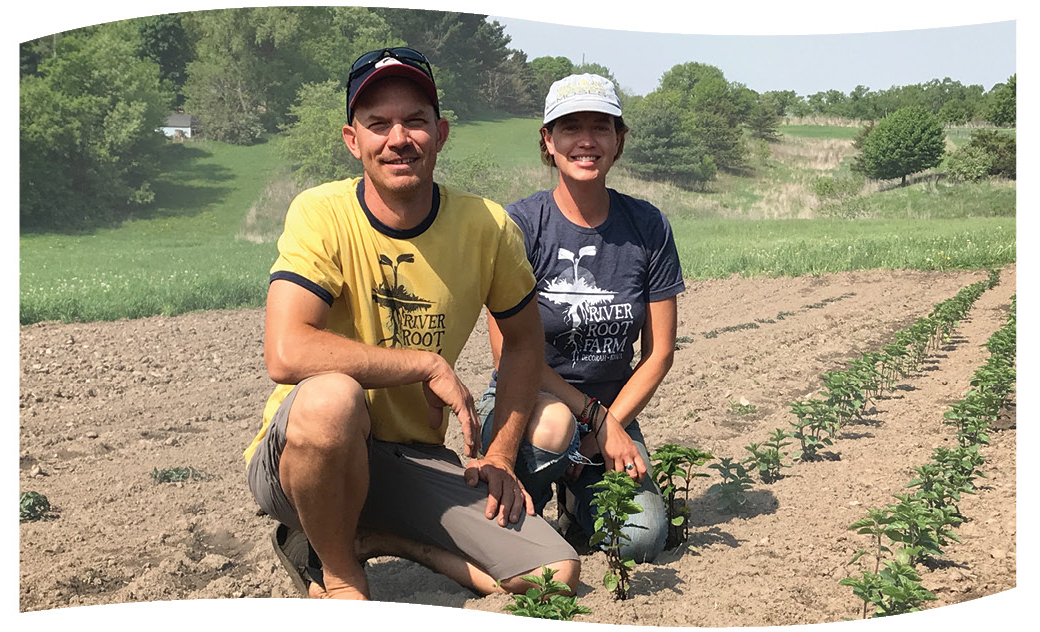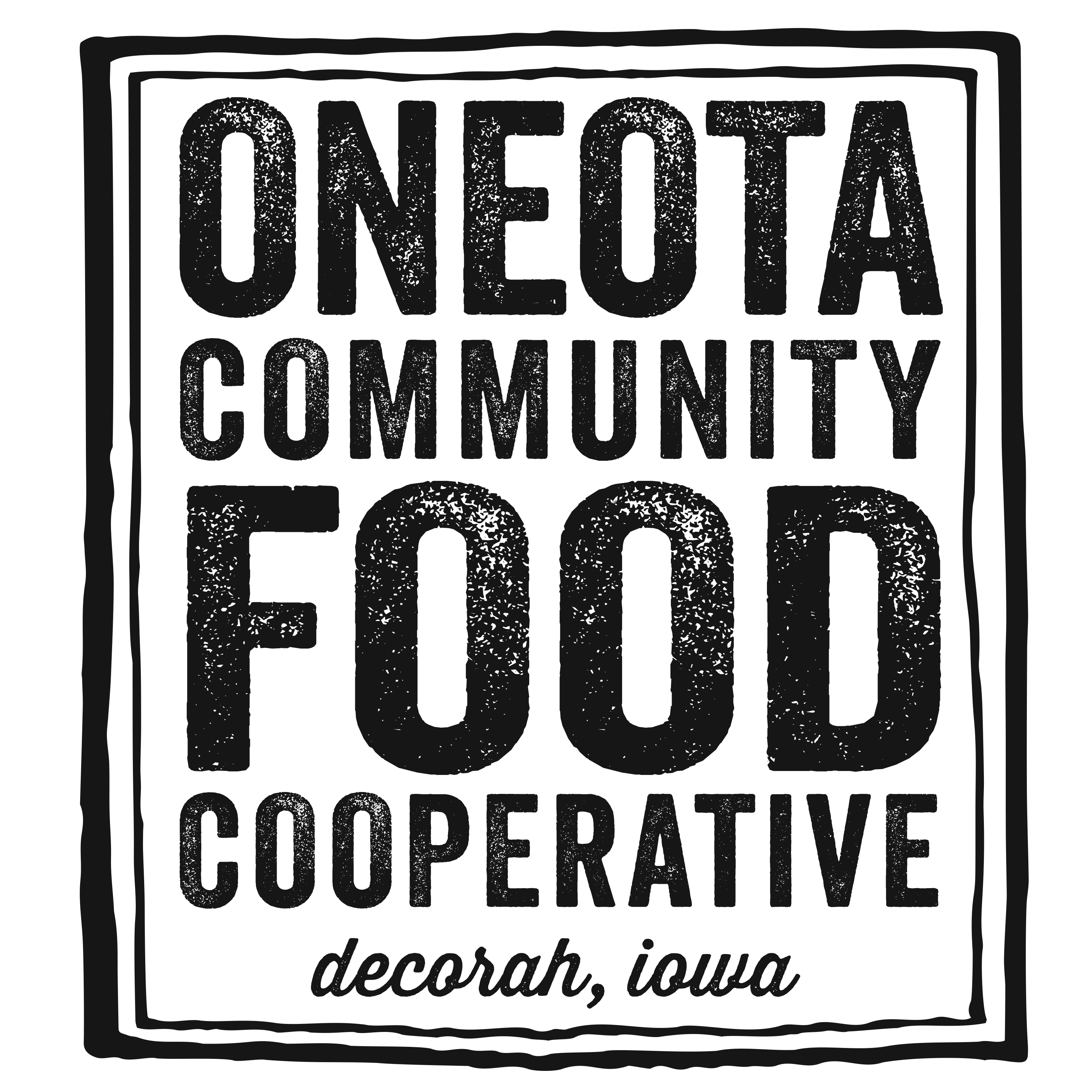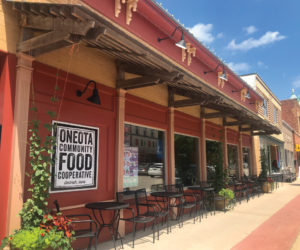 Katie Prochaska and Mike Bollinger have been farming at River Root Farm since 2009. They’ve been supplying the Co-op since then also. Before planting anything, they did some market research, discovering which produce items were trucked in from California that could be grown locally. They settled on greens, fresh herbs, and microgreens—and they’ve specialized in those items since.
Katie Prochaska and Mike Bollinger have been farming at River Root Farm since 2009. They’ve been supplying the Co-op since then also. Before planting anything, they did some market research, discovering which produce items were trucked in from California that could be grown locally. They settled on greens, fresh herbs, and microgreens—and they’ve specialized in those items since.
“We wanted to replace products that come in from Mexico and California.” Mike claims the greens they grow—lettuces, spinach, kale—are his totem veggies. Katie goes for the herbs. “The smell of the field at harvest time is the best.”
They sell to food co-ops, local restaurants, and farmers’ markets.
They never went the CSA (community supported agriculture) route. Coming up, they’d never worked on CSA farms. It wasn’t the model they trained in, so it was never a consideration. What they were trained to do is run a four-season organic farm in the upper Midwest.
Farm Apprenticeship
After graduating from Luther College in Decorah, Katie went into the Peace Corps and was posted to Mali. She spent three years there. This was her first experience with gardening. In Mali, she worked with women’s groups and they trained her. Mike, her friend from Luther College days, showed up in Mali and worked with Katie there. What did you learn there that you still use?
“Laughter,” Katie says. “It’s the poorest country in the world, but their attitude is so positive.”
Returning from Africa, the couple landed a residency at the Good Life Center in Maine. The center is the historic homestead of organic farming pioneers Helen and Scott Nearing. While at the center, Mike and Katie met Eliot Coleman and Barbara Damrosch, who run a four-season organic farm down the road from the center. Eliot and Barbara offered the two young farmers jobs when the residency was over and have continued to mentor Katie and Mike over the years. Coleman and Damrosch have been exploring and writing about the use of high tunnels to extend the season for farmers in colder climate zones. Katie notes that the extended season high tunnels open markets to farmers that they wouldn’t otherwise have.
From Maine, Katie and Mike found jobs at Chicago’s Botanical Garden. Once back in the Midwest, they helped set up a farm just outside of Lake Geneva, Wisconsin, learning how to launch, as well as maintain, a farm. Mike notes that “there’s a huge difference between walking into a working farm and setting one up.” In addition, they co-founded Four Season Tools to fill a need they saw for tools that small-acreage farmers could use to be more successful.
Eventually they started looking for land where they could apply all that they’d learned to a farm of their own. “We chose Decorah, and moved back to Iowa in 2009 to put infrastructure in place,” Mike says.
River Root Farm was founded in 2009. Their first child, Oliver, was a year old and Adeline came along two years after that.
How Oneota Gets December Spinach
The River Root couple learned four-season gardening from Eliot Coleman, a pioneer of the use of moveable greenhouses, or high tunnels. Coleman worked for some years in France, where farmers have long extended their growing season through the use of cold boxes and plant covers. Beginning in the 18th century, Parisian market gardeners supplied greens to the city well into the cold months. A farmer may not be growing oranges in Paris, or Decorah, but certain plants even prefer colder temperatures.
Coleman reckons that through the use of unheated high tunnels with an additional blanket or covering positioned just above the crop, the growing season can be readily extended in Maine—or the upper Midwest.
River Root doesn’t grow quite all year. Work/life balance is key for them. They shut down in January to vacation and catch up on accounting. But because of the high tunnels, River Root continues to harvest spinach, lettuce mix, and Asian-style leafy greens into December.
They have 5,760 square feet of plantings in two greenhouses (buildings with some heat) and about 13,000 square feet of plantings in five high tunnels (in-ground planting with no supplemental heat).
River Root uses floating row coverings in the high tunnels to protect the plants. They put one layer of fabric down when the overnight temperature drops to the mid-20s and they put two layers down when the temperature goes below that. Katie reports that “some folks use three covers once it gets into the teens, but we haven’t gone there yet.”
The high tunnels are relatively lightweight—compared to greenhouses—so they can be moved to avoid soil depletion. River Root rotates their crops and uses multiple green manures to give the soil a chance to rest and regenerate. They use straw mulch for their summer crops, which gets worked into the high-tunnel plots as well. “We make our best effort to soil test regularly and manage accordingly,” Katie says.
After their January break, the planting begins again in February.
“Bedding plants and seed starters are first,” Katie says. “We grow for Seed Savers, so we have to start seeds in February.”
They’re certified organic. “When we were farming in Maine,” Katie says, “the markets demanded it.” The argument is that the diseases and pests that chemical input farming attempts to mitigate could be better managed by careful organic soil management. Healthy soil makes for healthy plants. “What do you need to feed the soil to make a healthy plant?” is the question Mike asks. Or as his former boss Eliot Coleman wrote, “The farm is not a factory, but rather a human-managed microcosm of the natural world. Whether in forest or prairie, soil fertility in the natural world is maintained and renewed by the recycling of all plant and animal residues, which create the organic matter in the soil.”
Climate response
Since a four-season farm seeks to extend its growing season into the winter months, the changing climate has not necessarily been unwelcome. “We’re seeing beautiful days, 70–80º temperatures, in March,” Katie says. “And the fall season is extended.”
That said, they’ve found that the change in rainfall patterns has been an issue. “We don’t get gentle rains too often any more. It’s pounding rain, or nothing,” Katie says.
River Root’s high tunnel system helps mitigate the heavy rains, and they’ve come up with other ways to work around the problems brought by climate change. For example, they now do more transplanting of seedlings rather than direct seeding to avoid washouts in heavy precipitation.
 Next steps
Next steps
River Root Farm has been growing for Seed Savers Exchange since the farm started. “We did a few flats of basil for them in 2009,” Katie says. “And in 2010 we started supplying plants for the visitor center,” Mike remembers. Two years ago, the fellow growing all the catalog plants for Seed Savers Exchange retired and River Root took that work on.
“Our first delivery is March 28. We have five big delivery dates through late May,” Katie says. We’re standing in a greenhouse, surrounded by sprouted microgreens and seed beds. The future looks very green and busy.
“I love the greens,” Mike says. “They’re a challenge, but if you hit all the parameters right, the freshness and taste is unbeatable.”
Originally published in the summer 2018 edition of “Co-op Shopper”, a publication of People’s Food Co-op, La Crosse, WI and Rochester, MN. Article written by Kevin Ducey, Marketing Specialist.



